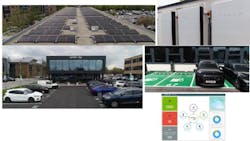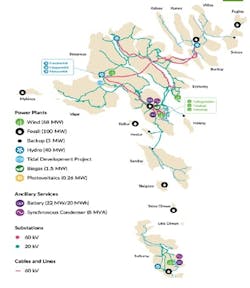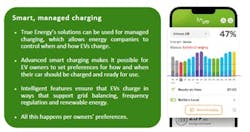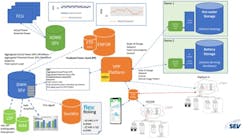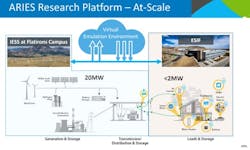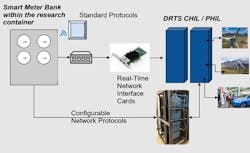Unlocking Carbon Neutrality: Strategies for Utilities to Integrate Control Grid-Edge Devices
Electric utilities globally are being compelled to upgrade their existing distribution and transmission systems due to the rising demand for load by residential, commercial, and industrial customers. For example, we are seeing 6 MW of spot load demand from a 100-e-Bus Fleet depot in the center of megacities such as New Delhi, India.
In addition, customers and regulators are increasingly concerned about the reliability and resilience of distribution systems, making additional investments likely to meet these expectations. However, the cost of implementing these system upgrades may not be justifiable in the short term, considering the short duration of peak loads or low frequency of extreme events or outages. Therefore, non-wire alternatives (e.g., distribution energy storage systems) and microgrids become more and more attractive, both for the utilities and their customers.
As these grid-edge devices scale from hundreds to thousands to millions, controlling these edge devices at scale is more challenging and difficult to connect and control in near real-time. The role of controller hardware in The Loop (CHIL) and Advanced Metering Infrastructure (AMI) has affected the evolution of the power grid, especially in distribution systems with large renewable energy integration and adoption of electric vehicles, thereby reducing risks of implementation of advanced DER control technologies.
No One-Size-Fits All Approach to Grid Edge Solutions
The grid edge consists of different types of residential, commercial and industrial customers, including EV fleets. They deploy different types of flexible loads and DERs such as manufacturing machines, heat pumps, pool pumps, LD and HD vehicles, solar, and battery storage. Depending on their operational requirements and use cases, the control strategies of these loads and DERs can be very different, and flexible solution strategies are required for optimal outcomes. When utilities are looking at controlling these devices, they need to account for their customers’ preferences and operational outcomes.
Aggregating and Controlling Residential BTM Grid Edge Assets - The Faroe Islands Use case
If you think a location in the North Atlantic is not the most straightforward starting point for achieving 100% carbon-neutral electricity production by 2030, you would be correct. However, an overhaul of the Faroe Islands energy landscape and an innovative approach to energy management is putting that target within reach. From a reliance on oil-fired power plants, the islands are increasingly powered by wind, hydropower — and soon perhaps even tidal energy. SEV, the electric utility serving the islands, is implementing a VPP solution to enhance grid flexibility using electric vehicles (EVs) as a core asset for load balancing and relying on renewable energy when it is available.
The shift to renewable energy presents challenges and opportunities for SEV. One challenge is maintaining grid stability with intermittent energy sources like wind and solar. This has led the Faroe Islands to pursue a strategy of complementary energy sources, such as wind, solar, hydro and tidal energy. Energy storage solutions, such as battery systems and hydropower dams, also play a key role, as do advanced grid management and real-time monitoring systems.
Today at Faroe Island, EVs represent roughly 2,000 out of 28,000 privately owned vehicles in the Faroe Islands. That number is set to rise exponentially. The same applies to the use of electric heat pumps. Early on, SEV recognized the need to activate EVs in support of the grid and renewable energy. This led to partnering with True Energy A/S, a Landis+Gyr Company, and activating EVs as flexible energy assets that support flexibility and grid needs. For example, EV charging sessions can be spread out over the night, when overall electricity consumption is at its lowest, and help SEV reduce grid strain.
SEV has deployed Landis+Gyr’s advanced AMI, Smart EV charge solutions, which will be integrated with AMI integrated distributed energy resource management systems (DERMS) and allow SEV to coordinate and manage distributed energy resources including EVs, heat pumps, and other renewable assets, in real-time. Integrating these energy assets into the grid as flexible resources makes it possible to dynamically adjust energy loads, thereby increasing stability, efficiency and resilience.
Accelerating EV Transition, Commercial and Industrial Electrification with Artificial Intelligence and Computing at the Grid Edge
The growing electricity demand from both EV charging and data center development is surpassing all expectations, resulting in the need to strategically locate these loads. These challenges are already emerging in certain global geographies and starting to emerge here in the Americas. Landis+Gyr is currently engaged with Tata Motors on a Proof of Concept (PoC) for a fleet electrification project in city of Bengaluru, India.
Tata Motors, India’s largest commercial vehicle manufacturer and one of the largest in world, has accelerated Bengaluru’s transportation electrification with the delivery of technologically advanced Starbus EVs to Bengaluru Metropolitan Transport Corporation (BMTC). TML Smart City Mobility Solutions Ltd., a Tata Motors subsidiary, and BMTC, have begun operation of 921 state-of-the-art electric buses. Landis+Gyr is also part of India Smart Grid Federation (ISGF), and a study by ISGF, “STUDY OF ELECTRIC VEHICLE CHARGING INFRASTRUCTURE PLANNING AND ROLLOUT FOR BENGALURU CITY, KARNATAKA” concluded that the increment in EV charging stations beyond the network’s existing capacity would have increased power losses and overloading situations. The feeders mentioned in the study were found overloaded and struggling with multiple undervoltage LT lines.
Landis+Gyr and TML Smart City Mobility Solutions are collaborating to deploy an advanced e-Depot Management System to mitigate grid impacts from large fleet loads at the depot, while at the same time ensuring that the e-Buses are charged when they need to be charged and can maintain their operations.
A related case study involves the local energy provider in Manchester UK, to deploy AMI infrastructure and Commercial Energy Management System at a Landis+Gyr microgrid in the UK. This unique system has edge computing capability in the Landis+Gyr smart meters that is processing large amounts of grid and energy use data, while disaggregating loads and using advanced AI algorithms to optimize and control loads and DERs on site. The site is also able to also sell power back to the grid during access solar generation.
Scaling Grid Edge Automation from hundreds to thousands and beyond
As the penetration of these grid edge devices increases, utilities are increasingly facing challenges to scale the ability to control these devices in real-time to maintain grid reliability and resiliency. Advanced AI Automation and DER management capabilities are fairly new to the industry and utilities, research labs are technology organizations are still in the process of determining the scalability, technology readiness and cybersecurity aspects when these technologies are implemented at scale.
Landis+Gyr and National Renewable Energy Laboratory's Advanced Research on Integrated Energy Systems (ARIES) are collaborating to develop a strategic experimental set-up for integrating advanced metering infrastructure with next-generation capabilities into NREL-ARIES project research assets. In order to meet ARIES’ objectives of developing large-scale grid emulation infrastructure, comprising a large number and diversity of devices, work has been ongoing to include up to 5,000 grid edge devices. This effort will allow researchers to evaluate the evolution of the power grid, particularly in distribution systems with significant renewable energy integration and the adoption of electric vehicles.
To add further variety to the relevant devices, it is proposed to include AMI—a research-ready infrastructure comprising 200 smart meters with enhanced functionalities—alongside 5,000 CHIL (Controller Hardware-in-the-Loop) devices at ARIES. These CHIL devices are capable of emulating grid edge devices, including EVs, building automation systems, and distribution automation systems. The CHIL devices will have the ability to emulate the operational behavior of grid devices while maintaining connections with other grid edge devices through their native communication protocols.
To establish a real-world environment in a control laboratory setting and understand the interactions, we will leverage the real emulation of grid edge assets by utilizing Controller Hardware-in-the-Loop (CHIL) for actual assets like AMI, distribution relays, and protection systems. Where actual assets do not exist, we will capture the characterization from emulation through transfer functions to model the dynamics and nonlinearity of the operation accurately.
This setup will enable researchers at NREL-ARIES and its industry collaborators to engage in rapid prototyping and technology validation related to advanced metering/smart meter and DER Management technologies.
Using sophisticated HIL (Hardware-in-the-Loop), Landis+Gyr AMI and DERMS technologies, and virtual emulation infrastructure, NREL will be able to develop and an emulation environment that replicates the power grid with millions of edge devices. This setup will allow for the testing of hundreds of utility use cases and de-risking technology deployments before field implementation.
Lessons Learned and Recommendations
As utilities and grid operators across the globe look to achieve carbon neutrality, the journey of Faroe Islands and TATA Motors offer valuable insights and strategies that can be replicated in other locations globally.
Lesson 1: Implement real-time data monitoring: Tracking energy demand and production in real time enables utilities to make dynamic adjustments, ensuring energy resources are efficiently distributed, match consumption, and support optimal grid performance and stability.
Strategies:
- Deploy advanced data analytics tools that integrate with the grid to collect real-time information on energy flows, demand, and renewable production levels.
- Use predictive algorithms to forecast demand surges and renewable output, enabling proactive grid management.
- Integrate demand-response systems and DERMS that can shift consumption patterns based on data insights.
Lesson 2: Adopt edge intelligence and smart grid technologies: With Edge intelligence and other smart grid technologies, utilities are better able to gather, analyze high frequency data and control grid edge assets, while adapting to changing grid conditions to maintain grid reliability.
Strategies:
- Upgrade legacy grid infrastructure with smart meters and sensors that enable bi-directional communication between the grid, consumers, and DERs.
- Enable distributed intelligence by deploying edge computing at critical points within the grid to process data locally and rapidly adjust energy flows.
- Invest in cybersecurity protocols to protect smart grid systems from digital threats, ensuring safe and reliable grid operations.
Lesson 3: Integrate distributed energy resources (DERs): DERs such as solar panels, wind turbines, and battery storage decentralize energy production, increasing the resilience and flexibility of the grid while reducing reliance on centralized power plants.
Strategies:
- Implement virtual power plants (VPPs) that aggregate DERs and manage them collectively, enabling smoother integration of renewable energy onto the grid.
- Build a robust DER Management Platform to effectively connect, aggregate, analyze and control DERs
- Offer Financial Incentives or rebates to encourage consumers to adopt DER technologies, ensuring widespread penetration in decentralized assets and power systems.
The above-described use cases will be presented in detail at the upcoming IEEE PES Grid Edge Conference 2025 in San Diego at the “Solving Renewables and EV Grid Integration Challenges by using AI and Edge to Enterprise platforms” and “Lessons Learnt from Implementing EV Charging Technologies for Residential and Fleet Use Cases Globally.”
About the Author
Shishir Shekhar
Shishir is a technology and business leader with 15+ years’ experience across Innovation, R&D, Product Management and Strategy functions in Technology, Utilities, and Automotive Industries. Currently, Shishir serves as Senior Director and Global Head of Technology and Strategy – Energy Transition Group at Landis+Gyr US and Subsidiary Director of True Energy A/S, A Landis+Gyr Company in Copenhagen, Denmark. Shishir is responsible for Product Innovation, Technology Strategy and R&D for Electric Vehicles and DER Management Solutions.
Shishir has extensive experience in developing and launching global products using Data Science, Artificial Intelligence, Digital Twins, Cloud Computing and IoT technologies and has managed multiple products lines from concept to launch. Before joining Landis+Gyr Inc, Shishir has worked for leading global organizations such as Itron Inc, MathWorks Inc, National Grid USA and Cognizant Technology Solutions at various capacities including Engineering, R&D, Industry Marketing & Strategy, Product Development and Product Management.
Shishir is a Senior Member of IEEE and was featured as Global Innovators and Energy Industry Influencers in 2020 by Energetica Magazine, Spain and India. Shishir has published over 8 research papers in IEEE and CIGRE; filed over 4 patents. Shishir holds a Master Degree in Business Management from Harvard University, USA and a Master of Science Degree in Electrical and Computer Engineering from Northeastern University, USA. Shishir was a Visiting Research Fellow at Massachusetts Institute of Technology (MIT) USA. Shishir received his B. Tech degree in Electronics and Communication Engineering from SRM University, India in 2009 and was awarded Notable Alumni of SRM University India in 2020.
Rob Hovsapian
Dr. Rob Hovsapian, ([email protected]), is a senior research advisor at the National Renewable Energy Laboratory (NREL). He holds a master’s degree in control systems and a doctorate in energy systems from Florida State University (FSU). At FSU’s Center for Advanced Power Systems (CAPS) and later at the Idaho National Laboratory (INL), he played a pivotal role in establishing digital real-time simulation (DRTS) research capabilities. At NREL, Dr. Hovsapian leads the Advanced Research on Integrated Energy Systems (ARIES) platform, where he is developing the largest DRTS capabilities cluster in the power and energy R&D sector. His work focuses extensively on advanced controls to optimize grid edge solutions and energy systems integration, particularly for renewable energy, microgrids and DERs. Dr. Hovsapian previously started and managed the Power and Energy Systems Group at INL and directed the US$96 million electric ship R&D consortium for the U.S. Navy. In industry, he pioneered integrated 3-D printing at General Dynamics, led projects for the USAF F-22 program at Northrop Grumman and managed semiconductor startups in the Pacific Rim. Globally, he has launched multiple advanced manufacturing facilities and established state-of-the-art power and energy research platforms and facilities. Dr. Hovsapian’s expertise lies at the intersection of advanced controls, real-time simulation and energy systems optimization, driving innovation in the power and energy sector.
